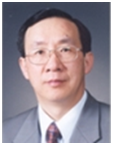Development of a high average power coherent beam combination laser system using self-phase-controlled Stimulated Brillouin Scattering Phase Conjugate Mirrors (SPC-SBS-PCMs)
演讲课题:Development of a high average power coherent beam combination laser system using self-phase-controlled Stimulated Brillouin Scattering Phase Conjugate Mirrors (SPC-SBS-PCMs)
演讲人:孔弘珍 Hong Jin Kong
演讲摘要:
A high average output power laser system operated at a high repetition rate with high output energy is necessary for applications including 2-D laser surface processing using hologram, 2-D laser peening, a laser-neutron generator, a laser-proton generator, a laser inertial fusion driver, and so on. However, it is difficult to achieve both a high repetition rate and high output energy in a solid state laser system. To increase the output energy of the laser system, the size of the laser gain medium should be increased. However, the parasitic oscillation from the large gain medium then results in loss to the output energy, and as such there is limitation to the output energy of the laser system. Also, the larger the laser gain medium becomes, the more difficult the cooling of the gain medium becomes. This causes a thermal lensing effect, a thermal birefringence effect, and so on, and these effects degrade the output beam quality. Moreover, the thermal stress can break the laser gain medium, thereby limiting the repetition rate of the solid laser system. Therefore, it is difficult to construct a high average output power system operated at a high repetition rate with high output energy by increasing the size of the laser gain medium. If we combine the available low power laser beams coherently, it becomes possible to achieve the desired output power. This method is called coherent beam combining (CBC). To achieve CBC, the wavefront of the laser beams to be combined should be flat and the relative phase difference between the laser beams to be combined should be less than λ/20. However, each laser beam to be combined has a differently distorted wavefront because they are amplified by different amplifiers. Therefore, the wavefront should be flattened to achieve CBC. A stimulated Brillouin scattering phase conjugate mirror (SBS-PCM) is one of the most promising method to flatten the wavefront. From 1972, when SBS was reported for the first time in the world, scientists have researched application of a SBS-PCM to CBC. However, the reflected beam from the SBS-PCM has an inherently random phase. The inherently random phase is due to initiation of the SBS grating from random noise in the SBS medium. Researchers have proposed several methods to resolve this problem, but it is known that it is difficult to apply these methods to CBC of more than four beams. In 2003, Kong et al. proposed a self-phase-control (SPC) method to lock the phase of the reflected beam of the SBS-PCM. This method is based on the fact that a SBS grating is initiated from the grating made by interference of the input beam and the reflected beam from the concave feedback mirror located after the SBS cell. By using this method, coherent beam combination laser using a SPC-SBS-PCM has been researched over a decade. As a result, coherent four beam combination using a SPC-SBS-PCM was successfully demonstrated at W class low average power (100 mJ class @ 10 Hz) and its feasibility was demonstrated successfully experimentally. Now, a high average power coherent beam combination laser using SPC-SBS-PCMs has being constructed. However, the SBS liquid media shows optical haze caused by the thermal effect due to the absorbed laser beam. This causes degradation of the reflectivity and fluctuation of the reflected beam pattern of the SBS-PCM. To resolve this problem, it is necessary to distribute the accumulated beam from the absorbed laser beam and select a medium that has smaller optical haze effect. In the presentation, the recent status of the development of the high average power coherent beam combination laser system using SPC-SBS-PCM will be presented.






















